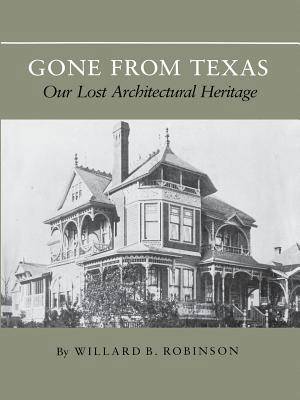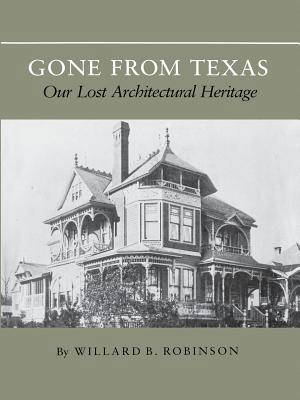
- Retrait gratuit dans votre magasin Club
- 7.000.000 titres dans notre catalogue
- Payer en toute sécurité
- Toujours un magasin près de chez vous
- Retrait gratuit dans votre magasin Club
- 7.000.0000 titres dans notre catalogue
- Payer en toute sécurité
- Toujours un magasin près de chez vous
Gone from Texas
Our Lost Architectural Heritage
Willard B Robinson
Livre broché | Anglais | Centennial Series of the Association of Former Students Texas A & M University (Paperback) | n° 9
48,95 €
+ 97 points
Description
The architecture of an area reflects and indeed embodies its history. When a significant portion of that architecture is lost, so is the grasp later generations have on their heritage. With more than 250 historical photographs and drawings and thoughtful commentary, Willard Robinson recaptures for Texans the cultural history of their state through the architecture that is gone. This handsome volume is unique in picturing comprehensively both public and private buildings and in illustrating the entire history of the state's architecture, unhindered by the difficulties of finding extant examples. It traces the architectural development of the state from Indian dwellings and Hispanic-colonial structures through the early twentieth century. It details the diverse influences on the built environment introduced by settlers from various origins--Germany, France, the Southeast United States. It shows how evolutions in technology and taste following the Civil War affected architecture, and it explores the Victorian splendor of the nineteenth century's era of elegance. Moreover, Robinson, relying heavily on primary sources, sets architectural trends in the context of the social, economic, and aesthetic forces that gave rise to them. His emphasis on the significance of lost architecture presents a powerful appeal for preservation of the important works that remain. Robinson has traveled widely through the state, visiting the sites of lost buildings, viewing remains, gathering photographs, and obtaining information. The result is a beautiful history of the architecture of Texas, from a perspective that might otherwise have been lost with the buildings.
Spécifications
Parties prenantes
- Auteur(s) :
- Editeur:
Contenu
- Nombre de pages :
- 318
- Langue:
- Anglais
- Collection :
- Tome:
- n° 9
Caractéristiques
- EAN:
- 9781585440054
- Date de parution :
- 19-01-81
- Format:
- Livre broché
- Format numérique:
- Trade paperback (VS)
- Dimensions :
- 211 mm x 281 mm
- Poids :
- 771 g

Les avis
Nous publions uniquement les avis qui respectent les conditions requises. Consultez nos conditions pour les avis.






